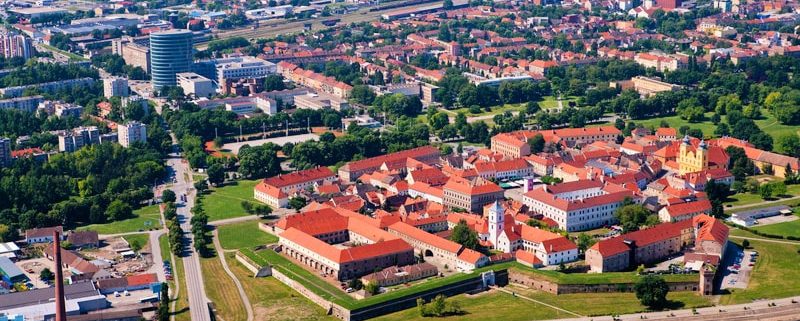
The city of Osijek in eastern Croatia, in the region of Slavonia, is the fourth largest city in the country behind Zagreb, Split and Rijeka with a population of just under 76,000 people. A charming place, Osijek is not on many travellers’ radars due to its position in Croatia and lack of international flights (despite having an airport); however, the city and general region are increasing in popularity which is an excellent thing!
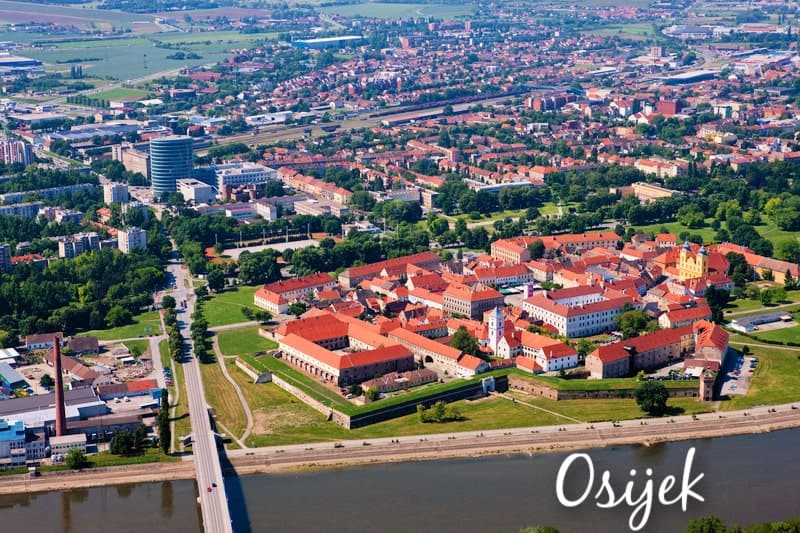
History of Osijek
In Roman times, a settlement named Mursa stood where Osijek is today although it was in the 6th century that Slavs came to the region. Osijek was first mentioned in 1196 (in its Hungarian form, Eszek) when what was then Croatia was united with the Kingdom of Hungary. The city was subsequently conquered by the Ottoman Empire in 1526 and, following its near complete destruction, was rebuilt in Ottoman style.
In 1687, the city was liberated by the Habsburg (Austrian) Empire and new defences were built. Osijek was granted the status of a Free Royal City in 1809 (designated to the most important cities in the Kingdom of Hungary) and was in fact the largest Croatian city in the early part of the 19th century. During this century, the city grew significantly in cultural and economic terms.
One of the main cities in Yugoslavia after 1945, the city was of course part of Croatia that gained independence in 1991. Due to its location, the city suffered significant damage (estimated at $1.3 billion) and, sadly, a high number of deaths in the War of Independence, particularly during the bombardment that took place from August 1991 to June 1992. With a population of over 100,000 people before the war, many residents also fled – it is thought as few as 10,000 people remained during the war. Fighting ceased entirely in 1995 when Croatia re-established control of the region.
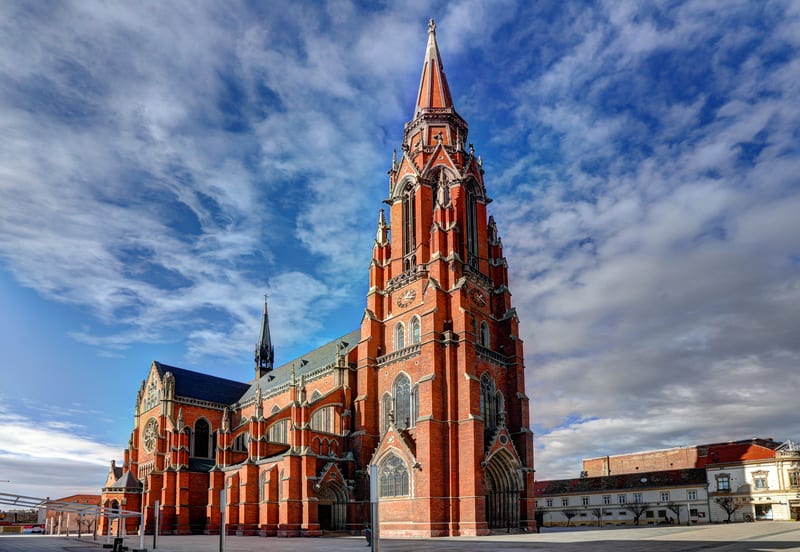
Getting to Osijek
Given its position in eastern Croatia relatively near the borders with Serbia, Hungary and Bosnia & Hercegovina, Osijek has some excellent international connections by bus and train (and road too, of course). The city also has an international airport – however, air connections to the rest of Europe are currently lacking, unfortunately.
By Air
Osijek Airport is the main airport in this region of Croatia and utilising this would undoubtedly be the best option for reaching the town quickly. Having said that, this small airport has few international flights to it…although, very useful for UK travellers, Ryanair do operate a route from London Stansted.
Other international flights to Osijek Airport include a route from Munich with Croatia Airlines that operates year-round. There are a good number of domestic flights to Osijek Airport with Trade Air (tickets also bookable on the Croatia Airlines website); they operate direct flights from Zagreb, Pula and Rijeka to Osijek.
You could also consider flying to nearby airports in neighbouring countries – for example, Budapest Airport or Belgrade Airport.
By Train
Osijek can be easily reached by train from Zagreb; there are regular, daily trains and the journey time is around five and a half hours. It would not be advisable to try and reach Osijek by train from Croatia’s other main towns and cities (as direct services do not run, and the total journey time would be rather long); if you did want to do so, you would really need to travel via Zagreb. You can, however, travel by train from other towns in this part of Croatia such as Vukovar, Slavonski Brod and Vinkovci.
By Bus
Bus is a better option if you’re attempting to travel long-distance withing Croatia to Osijek. Here are some of the possible direct bus routes to Osijek:
- Zagreb to Osijek – numerous daily buses – journey time around 4 hours
- Split to Osijek – 2 daily buses – 11-11.5 hours
There are a number of international bus services to Osijek from neighbouring countries, including services from Bosnia (Sarajevo), Serbia (Novi Sad and Belgrade), Hungary (Budapest) and Slovenia (Maribor). There are also bus services from further afield, including from Switzerland and Germany.
By Car
Travelling to Osijek by car is pretty speedy thanks to the motorway system. For example, from Zagreb, you can make use of the A3 motorway (and then the A5) which would make the journey time about 3 hours. The A3 motorway, in fact, stretches from Slovenia to Serbia whilst the A5 goes down to Bosnia & Hercegovina (and will eventually reach Hungary too), so Osijek is rather well connected by road to neighbouring countries as well.
Getting Around Osijek
From Osijek Airport to Osijek
Pleso Prijevoz operates an airport shuttle service to the main bus station in Osijek (and return). You can find timetable details and ticket information on their website.
Public Transport
The main way of getting around Osijek is by bus, although the city also has two tram routes. (Hooray – who doesn’t love a tram?!) There are nine bus routes in Osijek, as well as tram route 1 running east – west from Zeleno Polje to Visnjevac, and tram route 2 running on a ‘snail’ type route in the centre from Bikara to Ulica Hrvatske Republike. (This one goes past the main bus and train stations.)
You can see a map of both the bus and tram routes on the Osijek City Transport website. A ticket for a bus or tram can be purchased from the driver – it costs €1.46 and is valid for one hour.
Not necessarily “getting around” – in fact, more like sightseeing! – a ride on the Kompa ferry is a must when here as a pleasant ride across the Drava River. The boat departs from outside the Restaurant Kompa and sails to the Zoo; sailings take place from April to October inclusive. The ferry is free.
Sightseeing in Osijek
Tvrda
Tvrda – short for Tvrdava (Fortress) – was built when the city was under Austrian rule. Work was completed in 1722 and the fortress – with its town walls and four gates – became one of the largest such fortifications in Europe. The town walls were torn down in the early part of the 20th century, unfortunately, and today only a section of them remains near the River.
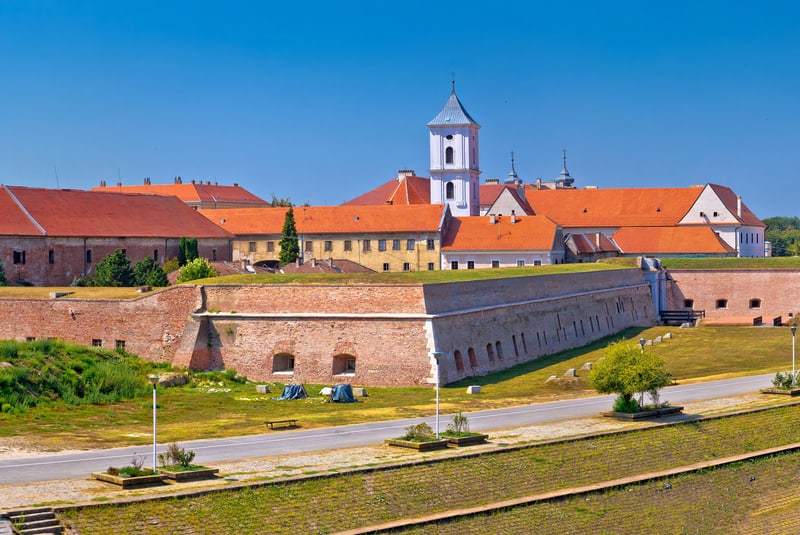
General’s Headquarters
Something you may well have “seen” already (for it used to be featured on the reverse of the 200 Kuna note), the General’s Headquarters on Trg Svetog Trojstva (Holy Trinity Square) is an impressive Renaissance-Baroque building, built in 1726 – indeed, for Austro-Hungarian military leaders at the time. These days, it houses Josip Juraj Strossmayer University. In front of the building is the Plague Column from 1729, built to ensure the plague never returns to the city.
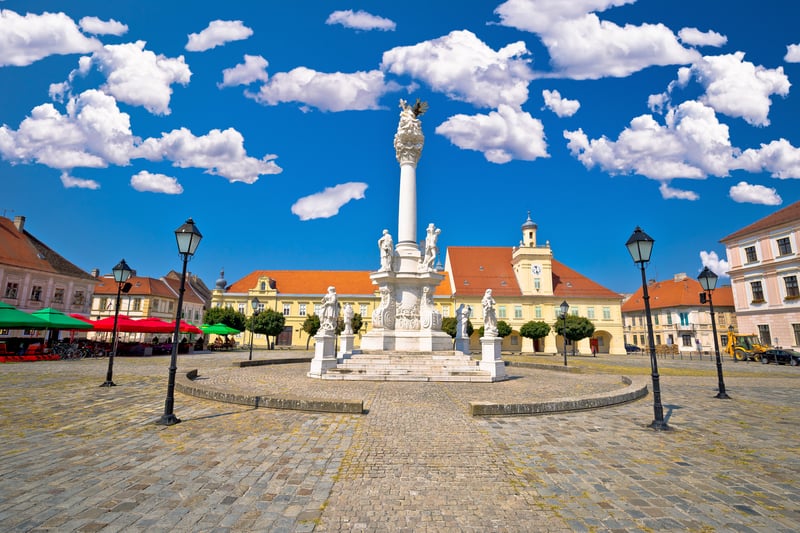
St Peter and Paul Co-Cathedral
With its 90 m-tall bell tower, the Cathedral (pictured further up the page) is the second tallest church in Croatia after Zagreb’s cathedral. Built in red brick (it was completed in 1898 after only four years of construction) which means it has a rather striking appearance, the “co-cathedral” name refers to the fact it is the cathedral of the Djakovo-Osijek Archdiocese. The Cathedral is home to five bells.
Main Square
Just by the Cathedral is the city’s main square, Trg Ante Starcevica which is named after a 19th-century Croatian politician. (There is a statue dedicated to him in one corner of the square.)
Sights from the War
Not perhaps everyone’s cup of tea, however, given Osijek’s recent turbulent history it is no surprise that there are a number of interesting sights related to the 1990s War of Independence. The most famous of these is the Monument to the Red Fico on Vukovarska Cesta (Vukovar Road) – this is a tribute to a real red “Fico” car (similar to an old-style Fiat 500) that was parked by an Osijek local in June 1991 to try and stop advancing Yugoslav Army tanks. (It was obliterated.) The Monument shows the red car rising up on a tank.
Just down Ulica Kneza Trpimira from the above is the Osijek Nepokoreni grad graffiti – this means “Osijek Undefeated City“. This was painted onto the wall in November 1991 when the city was being heavily attacked, and the day the nearby town of Vukovar was occupied. The wall is a protected monument.
Some buildings damaged during the war had parts of their damaged brick facades painted a striking red colour to highlight their “wounds”.
Zoo
Osijek Zoo is the largest zoo in Croatia, situated away from the main part of the city, in an area with large open spaces for some of the animals to roam. The Zoo is home to around 650 animals – 80 different species, 20 of which live in aquariums and terrariums. Come here and see giraffes, zebra, antelopes, camels, chimpanzees, African lions, brown bears, wolves, bison, meerkats, ostrich, dwarf crocodiles and more! The Zoo is open year-round, and children under 3 go free.
Beaches in Osijek
Beaches…say what, now? No really! Copacabana Beach (we’re sure it’s just like the famous Brazilian one…) – also know as Kopika – is the place to head to in the hot summer months, where you can relax on the sandy beach, take a drip in River Drava and enjoy drinks in the sun.
Eating & Drinking in Osijek
If there are two things you must try when in Osijek or the wider region, make it a local wine and a local beer! For the latter, it’s Osjecko beer you must try; it’s the oldest of all the Croatian beers, first being produced in 1697.
Pivnica Runda is probably one of the best places to grab a beer in the city!
Lumiere is a very pleasant mid-range restaurant serving typical local cuisine (there’s a wide range of meat specialities).
Restaurant Waldinger is the place to come if you’re after a special meal in a charming, elegant setting.
Head to Petar Pan for amazing cakes and ice cream!
Accommodation in Osijek
There are a good number of three and four-star hotels in the town, all of which would be fine options for your stay here.
Four-star hotels include the elegant Hotel Waldinger and Hotel Osijek (which has its own spa and wellness centre), both of which are centrally located. Zoo Hotel is the place to stay if you have young children as there’s an onsite playground; it’s about a 15-minute walk to the centre of town.
For three-star options, you will find the Hotel Silver, the Hotel Vila Ariston with its excellent location, and the modern Hotel Millennium.
For hostels, there are also some very good choices, including the very smart Hostel OS (double rooms and beds in mixed dormitories) right in the centre of town; the Hostel Lega House (private rooms); the Hi Hostel Stara Pekara Osijek (twin rooms and beds in mixed dormitories), which is actually located within part of the fortress; and the Hostel Tina (single, double and triple rooms).
For private accommodation, consider the highly-rated Sobe Merlon, Centrum Osijek and the bed and breakfast Pansion Komfor Fitea or Travego Osijek.
Other options to consider include the Red Dot Jazz Garden which sleeps a group of nine;
Day Trips from Osijek
Kopacki Rit Nature Park
Kopacki Rit Nature Park is only a 15-minute drive from Osijek, and well worth a visit as it’s a stunning wetlands area located close to where the Drava and Danube rivers meet and covering an area containing many lakes, canals and ponds through multiple forests. The Park is home to numerous waterfowl birds, many species of fish, plenty of deer, wild boar, otters, pine martens (the kuna!), plus the white-tailed eagle – the symbol of the Park. Kopacki Rit is open year-round and you can experience the best of the Park by joining one of the organised boat tours.
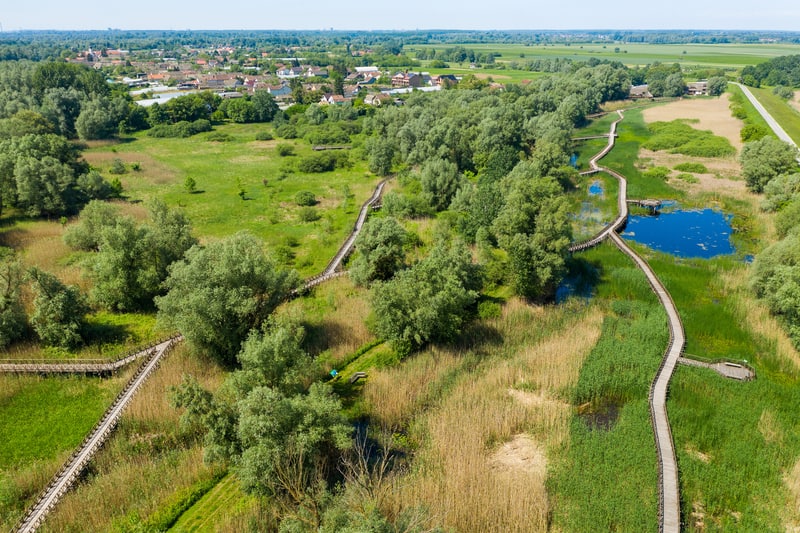
Ilocki Podrumi
Although wines in Croatia’s coastal regions are becoming more and more well-known, the wines of Slavonia are absolutely of the highest quality too. One of the best-known producers is Ilocki Podrumi (Ilok Cellars), whose wines were served at Queen Elizabeth II’s coronation, and who today produce around 4 million litres of wine a year. Located about 70km southeast of Osijek – practically right by the border with Serbia – you can visit the estate and sample some of their very fine wines at their Old Wine Cellar Restaurant.
Events in Osijek
The Osijek Summer of Culture runs for the whole summer with a great number of happenings – theatre, art, film, music and more.
Days of the First Croatian Beer (Osjecko, as mentioned above) is a ten-day event every September celebrating…beer! (Plus good food, music and general merriment too.) About 50,000 people normally attend!
Like many places all over Croatia, Osijek also enjoys vibrant celebrations in the run-up to Christmas and New Year. One of the highlights is the specially decorated Christmas tram which runs every December.
You can also find out more about events taking place in the general area on our Events in Eastern Croatia page.
More Info
There’s a whole heap of information on the town on the excellent and very extensive and informative Osijek Tourist Board website.
